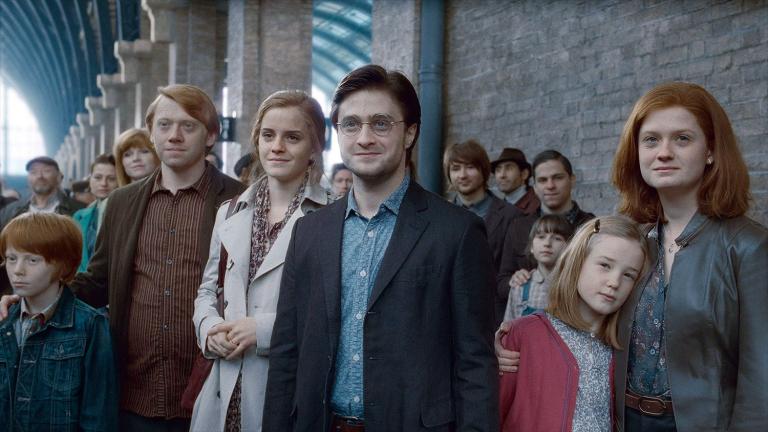Why the Harry Potter Film Epilogue Never Stood a Chance
When Harry Potter and the Deathly Hallows Part 2 was filmed, the production team struggled with its famed "19 Years Later" epilogue.

After seven books, eight films, a theme park, and the creation of a veritable merchandising empire, you can hardly blame the Harry Potter production team for wanting to go out on a high note with the final installment of the beloved film franchise. But one final mountain loomed ominously before Harry Potter and the Deathly Hallows: Part II could wrap: the dreaded epilogue.
This “19 years later” segment closes the final Harry Potter book with Harry and company at King’s Cross, sending their own children to Hogwarts. In theory, it provides closure, a happy ending for Harry, and the satisfaction of continuity with another generation of witches and wizards off to school. In practice, it was an absolute beast to film. For one, no one knew the best approach to handle the hair or the makeup required to age the 20-something cast into believable 39-year-old parents of 11-year-olds.
They filmed it once, and even the hair and makeup people on the crew admit that they went too far, giving Ron a potbelly, jowls, and a badly receding hairline. (Rupert Grint himself said of the initial cut: “The images of me still haunt me.”) When photos from the original epilogue leaked, there was an immediate fan reaction, and it was not positive. Months after shooting had wrapped, the main cast was hastily called back for reshoots, this time with a simpler, more low-key visual aesthetic. The production team was evidently satisfied that they had done their best, and this was the version that made it into the final cut of the film.
The scene is fairly simple. The golden trio reunite at King’s Cross to see their children off on the Hogwarts Express. Harry’s youngest son, Albus, is anxious that he will be placed in Slytherin, and Harry comforts him, reminding Albus that one of his namesakes was in Slytherin and still a brave man. And, besides, the Sorting Hat takes your own preferences into consideration before placing you into a house. The kids get on the train, their parents tearfully watch them leave, and one would believe that all is sunny in their world, mostly because Rowling tells us so.
It doesn’t work on screen. But it isn’t the hair or the makeup departments’ fault. Indeed, there probably isn’t anything the production team could have done, other than to acknowledge that the scene shouldn’t be included at all. The issues with the epilogue go much deeper than bad aging makeup or weird hair. It’s not the execution of the scene but rather the scene itself that doesn’t work. After building an entire magical world from scratch, J.K. Rowling boxes the characters into a rigidly conservative future, fundamentally misunderstanding and actively eschewing the logical path she herself has put the characters on through their adolescence.
The logical closure point of the story is the aftermath of the Battle of Hogwarts, and Rowling herself has admitted in an interview that the main reason she was so keen to include the epilogue had nothing to do with the main cast of characters, but instead because she was eager that readers know that poor, orphaned Teddy Lupin, son of Remus and Tonks, would be okay in the end. That sentimental instinct would ultimately undermine the growth of each of her lead characters.
Let’s review. On the surface, this epilogue is positioned as Harry Potter’s ultimate happy ending. The boy who grew up alone and unloved now has a warm, tight-knit family of his own (and as if that wasn’t enough, his two best friends are conveniently part of that biological family!) But it’s important to remember that Harry spends the entire series utterly burdened by the past. The most important event of his young life happens at its very beginning, when he survives the curse from Lord Voldemort. Throughout the books and movies, he is constantly looking backward: poring over old photographs of his parents, physically exploring memories from their time at Hogwarts, ruminating on the life and history of Tom Riddle. In one of the later books, he’s given the opportunity to have career counseling with Professor McGonagall, and he’s completely nonplussed: the idea of life after the urgency of his battle against Voldemort scarcely seems to have occurred to him.
There’s never an opportunity to face the future; it’s always about resolving the issues of the past. And although in this epilogue he is, literally, in the future, it nonetheless reveals that he’s never stopped being beholden to the past. The proof is in his children’s names: James Sirius, Albus Severus, Lily Luna. With the exception of Luna, he’s used his sons and daughter to serve as a living mausoleum for the long-dead. The only conversation we hear from Harry to his son Albus is one of legacy, honoring the memory of old mentors. Rowling clearly intends this vision of Harry to be a positive one, but it comes across as sad more than anything else: he’s still as weighed down by the past as ever.
Then we come to Ron and Hermione, their relationship a letdown for him and a tragedy for her. Hermione Granger, the brightest witch of her age, intelligent and fiercely ambitious, is still with her high school boyfriend who has never quite appreciated her properly. Ron is smart in his own way, but not in the same way that Hermione is, and she’s set herself up for a lifetime of never being intellectually stimulated by her husband. They make sense as a teenage flirtation, close friends who edge the line between companionship and romance, but it’s hard to imagine an adult relationship between the two of them where Hermione isn’t unfulfilled and Ron hopelessly insecure.
And finally, there’s Ginny, who is betrayed perhaps most of all. Her character is one of the biggest surprises of the series, as she emerges from the non-entity status as Ron’s little sister into a person in her own right, one who is funny and powerful and utterly self-confident. Constantly underestimated by everyone, she does things in her own way, and unlike many big screen love interests, seems to have a life that doesn’t solely revolve around her boyfriend. But then she turns up in the epilogue, and it’s almost like she’s been lobotomized. Resplendent with aggressively awful mom hair, she walks a pace behind her husband and smiles wanly, without ever saying a word. Firecracker Ginny, who once boldly took her hypocritical brother to task for trying to slut shame her, is turned into human wallpaper.
In the Harry Potter epilogue, JK Rowling’s tendency to cling stubbornly to “traditional” cultural norms, a tendency that has developed into vocal transphobic behavior in recent years, is fully exposed. She does a disservice to her characters, seemingly because she can’t imagine a happier ending for them than being in a heterosexual marriage to their high school sweetheart, dropping the kids off at school. After an entire series of magical hijinks and found family, this reversion to normalcy comes across as utterly disheartening. When we look at Harry Potter and the Deathly Hallows: Part II, it’s easy to blame production issues for why the epilogue underwhelms. But the truth is, it doesn’t work because it tries too hard to fit Rowling’s rigid definition of a happy ending, without consideration for the logical trajectory of the characters. A decade later, it’s one of the major narrative failures of the impressively adapted film series.
